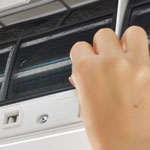HVAC Winter Storage NYC
How to Properly Store HVAC for Winter!
It’s best to start a post-summer ritual for your HVAC during the fall unless you plan to use your reversible air
conditioner during the winter. This is the time to unload, cover, and properly store HVACs until the
next season.
Storing your window HVAC may seem like a lengthy and troublesome process. However, by doing this, you
not only keep your HVACs in top shape during the winter season but also save on your utility bills.
You might be wondering how one can save on the utility bills by this.
Storing Your HVAC is This Easy!
- Why Should You Store Your HVAC?
- How to Store Your HVAC During Winter
- Post HVAC Storage Considerations
Why Should You Store Your HVAC?
HVAC storage is essential for a couple of reasons. The first reason is pretty obvious; you prevent
exposing it to the off-season elements, avoiding any damage to it. Components like the outdoor fan, compressor,
and refrigerant pipes can be damaged during extended shutdown periods.
The second reason is to prevent heat loss in the winters. When you have an HVAC installed, especially
a window HVAC, there is a small gap between the HVAC itself and the window frame. If not
sealed properly, air can leak out through this gap and be a cause for concern. Removing the HVAC and
shutting down the empty cut-out can then prevent warm air from leaking out of the room.
Another reason is that you want the maximum light to be coming into your room in winter. Window HVACs
take up space in the window and block a considerable amount of light from coming into the room. Removing the HVAC when it is not in use frees up valuable space, allowing you to enjoy the maximum sunlight during day
time, helping to keep the room warm.
How to Store Your HVAC During Winter
Let us go through some of the pre-storage considerations for your HVAC, and then see how you can go
about putting your HVAC in storage.
Pre-Removal Checks for HVAC
-
Every successful job starts with planning and preparation. Ensure you have the proper tools needed
for the job, such as a screwdriver, pliers, and adjustable wrenches. It is wise to enlist a friend’s
help to assist you with the removal and storage, as HVACs do tend to be heavy. If you are
confident of your physical strength, then you can proceed on your own too.
Remove the HVAC Before Putting It in Store
-
As discussed before, HVACs are heavy pieces of equipment. Get the help of your friend, and do
not do this job alone. Remove any sealant on the edges of your window HVAC, and gently pry it loose.
Pull-on the HVAC and slide it out of the space. Be sure to support it from underneath and not
let it fall down. This is where your friend or your muscles will come in handy.
When the HVAC is sufficiently loose, tilt it away from you and towards the outside so that any
residual water in the drip tray will fall. Finally, pull the HVAC all the way out, and lower
your window back down. If the HVAC was in a cut-out cavity, cover it back up. These steps lay
down the foundation for window HVAC storage.
Give Your HVAC a Good Wash!
-
Storing a dirty HVAC can be harmful and lead to damage. Moreover, mold and fungus can build up
if water has accumulated in the drip trays. Thus, it is a good idea to give your HVAC a
thorough clean-up before you store HVACs away for winter.
Pack Away Your HVAC Before Storing It
-
For storing your HVAC in New York, Bronx, Brooklyn, Manhattan, Queens and Staten Island , dry off all the components, lay them out together and reassemble them.
You can consult the user manual or Call Us Hitech Central Air Inc. at 718-674-6606 if you are unsure of anything.
Once reassembled, use an HVAC cover for
winter to wrap up the HVAC. This keeps the HVAC free from any more dust or insects
which might get inside. For this purpose, you can use a window HVAC cover for winter.
Once done, place the HVAC in a dry place, ensuring that there is no moisture within the air
conditioner or in the room. Excess moisture can promote bacteria and algae’s growth, which will be tough
to remove later on when you get the HVAC out in the summers. Do not store HVACs
outside in the extreme cold; there is a chance that the fins or plastic get damaged or cracked due to
the thermal differences. It is preferable to keep the HVAC in a dry and moderate
environment.
Be sure to store your HVAC in an upright position so that the internal components do not
dangle around (which they shouldn’t ideally) and the refrigerant does not leak. Otherwise, there is a
chance of compressor damage, which is expensive.
Post HVAC Storage Considerations
Winters have gone, and it’s time to welcome the bright and shining sun. But with it, temperatures can soar, and
you need your HVAC back. Take out the HVAC from the wrapping it was covered in, and let it
soak the sun for a while. Take out the filter and front cover before this process. Using pressurized air, blow
off some of the dust that might have accumulated on the HVAC, and you are good to go.
HVACs are expensive, and it is wise to take care of them and keep them running for years to come.
Taking care of your HVAC during the winter season, and using an HVAC cover for winter when they are not
in use, is just one step in ensuring that your HVAC stays in excellent condition. Regular maintenance
checks are another way to keep them healthy and prevent costly repairs. In the case of reversible air
conditioners, you do not need to store them instead of using their heating in winters. With the help of smart HVAC
controllers, you can even enjoy smart heating for maximum comfort, convenience, and energy saving in winter.
Hitech Central Air Inc.
Phone :
718-674-6606
718-674-6606
Main Office :
Hitech Central Air Inc.
Address :
111-33 Lefferts Blvd South
Ozone Park, NY - 11420, US
9.00 a.m. to 9.00 p.m.
New York, NY 11420







